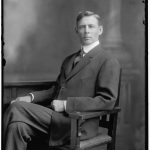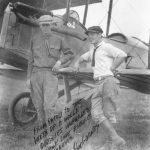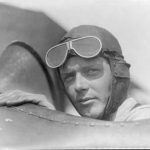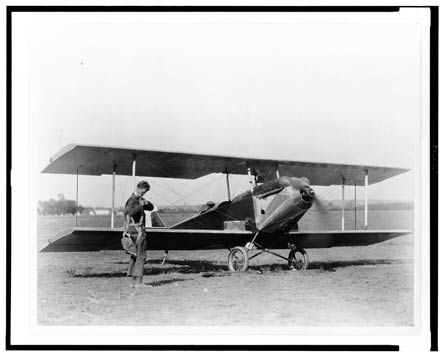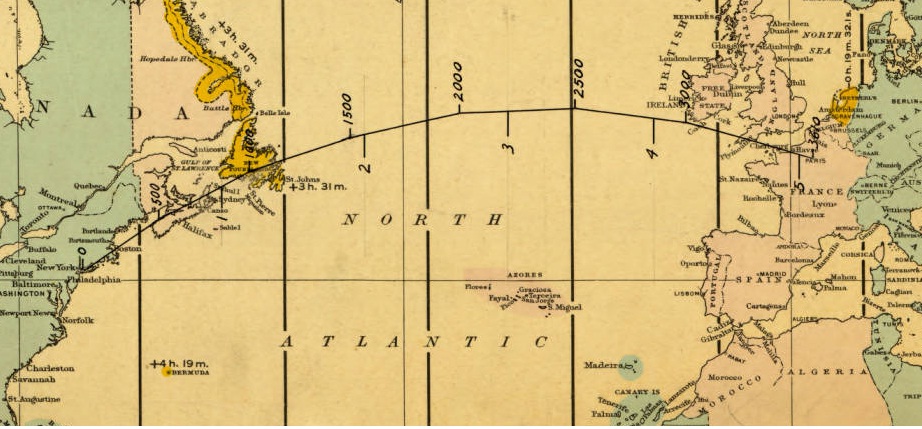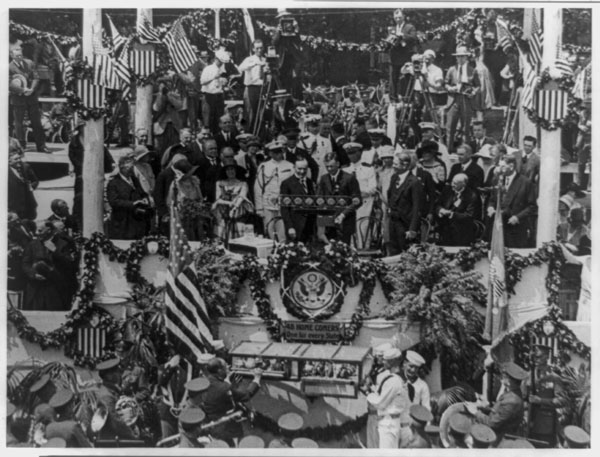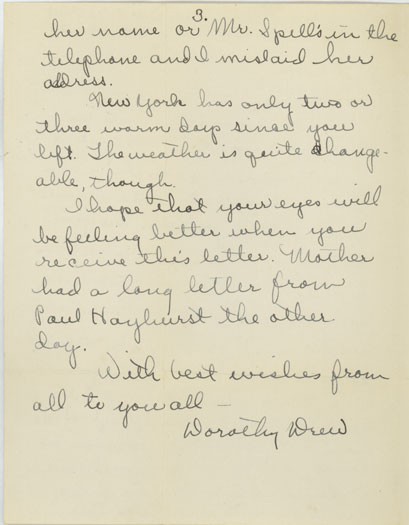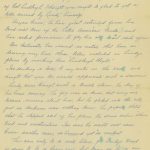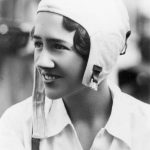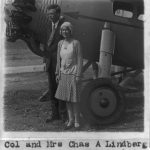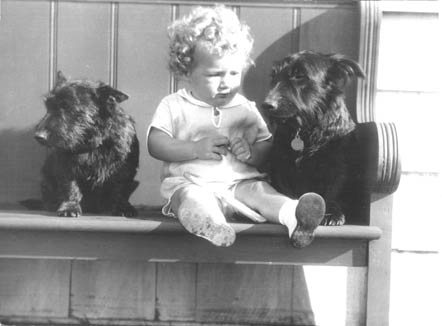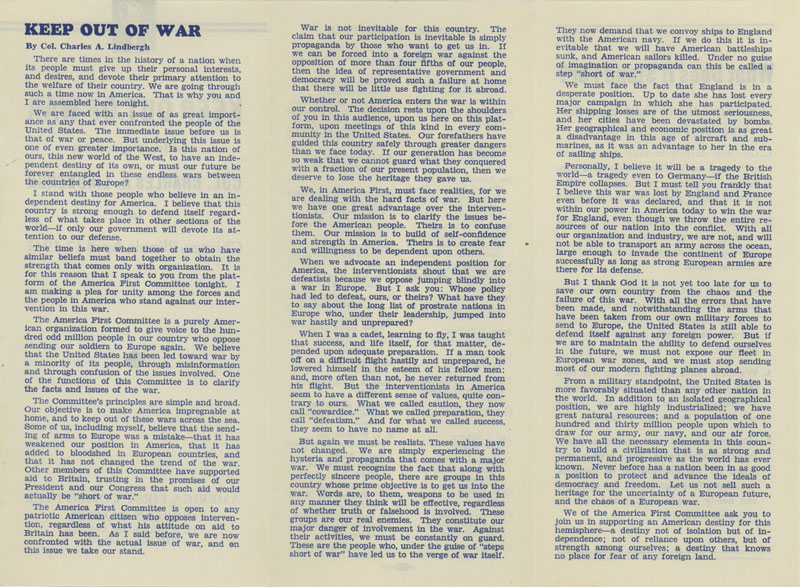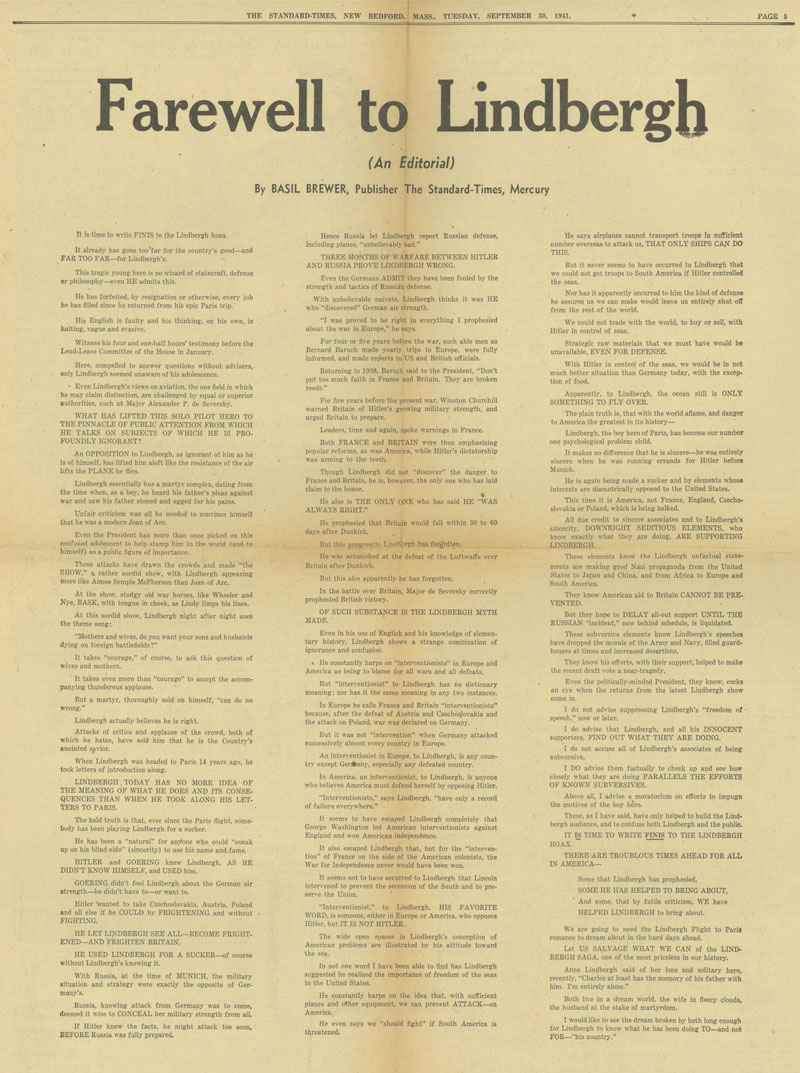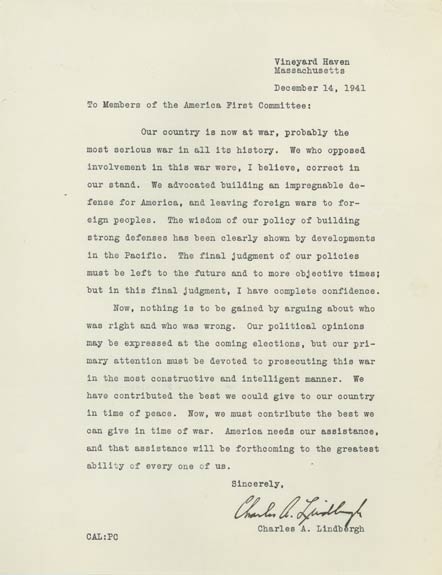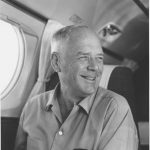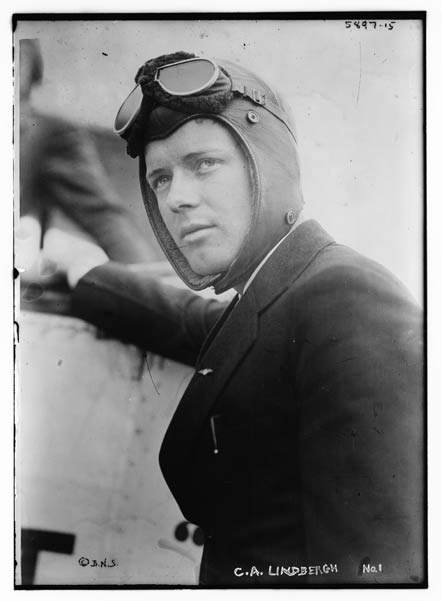
Charles Lindbergh

Introduction
Charles Lindbergh was a famous aviator. In 1927 he became the first man to successfully fly an airplane across the Atlantic Ocean. He called his airplane the Spirit of St. Louis, and his courageous feat helped make Missouri a leader in the developing world of aviation.
Early Years and Education
Born in Detroit, Michigan, on February 4, 1902, Charles Augustus Lindbergh grew up near Little Falls, Minnesota. His father, Charles August Lindbergh Sr., had immigrated to Minnesota from Sweden with his parents in 1860 and graduated from the University of Michigan Law School in 1884. The senior Lindbergh married Evangeline Land in 1901. Evangeline came from a prominent family in Detroit, Michigan, and graduated from the University of Michigan with a degree in chemistry. She earned a master’s degree from Columbia University in New York.
The Lindberghs lived in Detroit until 1905, when their house burned. The family moved to Little Falls, where Charles Sr. was soon elected to Congress. While young Charles spent much of his childhood from 1906 to 1916 in Washington, DC, he preferred the outdoor life of Minnesota to the city life of Washington.
When Charles was very young, a pilot flew to Little Falls to show off his airplane and sell rides in it, a practice called “barnstorming.” Although Lindbergh didn’t get to fly with the barnstormer that day, he was filled with a desire to learn. He dreamed of becoming a pilot one day.
Lindbergh was not a particularly good student in school. Instead, he was interested in mechanical things like cars, farm equipment, and motorcycles. When the United States entered World War I in 1917, Lindbergh was too young to join the armed forces, but he was excused from school to run the family farm for the war effort. Lindbergh’s father was firm in his opposition to America’s joining the war, and his view cost him his seat in Congress in 1916. This meant fewer trips to Washington DC for Lindbergh.
When Lindbergh turned eighteen, his parents convinced him to enter the University of Wisconsin. He studied mechanical engineering, but he dropped out in his second year of study.
Learning to Fly
In March 1922, Lindbergh left Minnesota and went to Lincoln, Nebraska, to work for the Nebraska Aircraft Corporation. The company bought old military airplanes, fixed them up, and sold them to the public. Lindbergh learned about airplane mechanics and had the chance to fly with company pilots on a few occasions. He even joined one of the pilots on a barnstorming tour. Lindbergh brought in customers by stepping out onto a wing of the airplane as he and the pilot flew into towns.
After a second barnstorming tour with another pilot, Lindbergh went to Georgia to purchase his own army surplus airplane—a Curtiss Jenny. Lindbergh spent a year barnstorming in his own plane and then decided to join the Army Air Service.
The army flying school, which was in San Antonio, Texas, was very difficult. Lindbergh had little trouble flying the Jennies and De Havilland DH-4B trainer planes, but he had difficulty with the classroom topics like photography and mapmaking. He had to work hard, but his efforts paid off. Out of the 104 cadets who entered the school in March 1924, only 18 remained a year later. Lindbergh graduated at the top of the class.
After graduation, Lindbergh was commissioned as a second lieutenant in the U.S. Army and then moved to St. Louis where he became an officer in the Missouri National Guard.
Mail Flying
With the new skills he had learned from the army, Charles Lindbergh was hired by Robertson Aircraft Corporation in St. Louis. He flew passengers and instructed flight students until 1926 when the company got a contract to fly airmail between St. Louis and Chicago. Lindbergh was made the chief pilot, responsible for scheduling and plotting the route. The flying was extremely hazardous. Airmail pilots were faced with poor weather, nighttime flying, and fatigue. Lindbergh became an experienced aviator in the process, and it was during these flights that he began to consider the possibility of flying across the Atlantic Ocean.
The Orteig Prize
In the 1920s, others were thinking about a transatlantic flight as well. In New York, a French businessman named Raymond Orteig offered a prize of $25,000 to anyone who could successfully fly from New York to France.
Several teams in France and the United States hoped to accomplish the feat and attain the prize. All of these teams had financial support and were planning to fly large airplanes with multiple crew members onboard to assist each other during their flights.
In the fall of 1926, Lindbergh’s odds of making the trip seemed slim. Lindbergh had only $2,000 of his own savings, he was considered too young and inexperienced to make the trip, and his idea of flying solo across the Atlantic seemed absurd to many people.
The Spirit of St. Louis
Lindbergh’s chances to make the flight improved in early 1927. He received financial backing from several important St. Louis businessmen.
Albert Bond Lambert was a pharmaceutical manufacturer and the owner of an airfield in St. Louis who helped Lindbergh. He hoped to promote air travel to and from St. Louis. Lambert Field in St. Louis is named for him. William and Frank Robertson, Lindbergh’s employers, also provided help. Earl Thompson, Harry Hall Knight, and Harold M. Bixby were other civic leaders who supported Lindbergh. Bixby suggested that Lindbergh name his plane the Spirit of St. Louis, and Lindbergh readily agreed.
The Spirit of St. Louis was built in California by the Ryan Aircraft Company and was a modified version of the company’s airmail plane. Lindbergh cut every bit of weight he could on the plane so it could hold as much fuel as possible. He couldn’t even see where he was going without a periscope because the plane’s front window area was replaced with a gas tank.
The Transatlantic Flight
The early morning of May 20, 1927, was dreary in New York, but the weather forecasts for his route over the Atlantic Ocean and his destination to Paris were good enough for Lindbergh. Even though he had slept little the night before and faced a thirty-three hour trip, Lindbergh decided to make his attempt.
Although Lindbergh first experienced good weather, he eventually ran into icing conditions that forced him to consider turning back until he made his way through. During the trip, he averaged around 100 miles per hour and varied his altitude from just a few feet above the waves in the daytime to over 10,000 feet at night. He kept the windows open most of the flight to keep from falling asleep.
Lindbergh flew what is known as a “great circle” route from New York to Paris. He flew from New York along the coast of Newfoundland and over Ireland to reach his destination. Looking at a flat map, his route seems to add miles to his journey. If, however, you connect New York and Paris with a piece of string on a globe, you’ll see that Lindbergh’s route is indeed the shortest.
Lindbergh landed in Paris at 10:24 p.m. on May 21, 1927, and was welcomed as a hero by a crowd numbering in the tens of thousands who had gathered for his arrival.
Lindbergh the Hero
Lindbergh received a hero’s welcome in France, Belgium, England, and the United States. A ticker tape parade in New York was attended by an estimated three to four million people. Wherever he went, throngs of admirers greeted Lindbergh, and his name became known worldwide.
In 1929, Lindbergh married Anne Morrow, the daughter of Dwight Morrow, a wealthy bank executive and U.S. ambassador to Mexico. Lindbergh was not comfortable with his fame and became even less so when his and Anne’s baby boy was kidnapped and killed in 1932. In addition to their own emotional pain from the tragedy, the Lindberghs had to endure intrusions by the press and fans. To gain some privacy, the couple moved to England in 1935.
World War II
While he lived in England, Charles Lindbergh observed as Europe descended into war. As a flyer, he could see the danger posed by Germany’s growing air force. He also noted how poorly prepared the British, French, and Russian air forces were in comparison with the Germans.
Just as his father had believed that America should not become involved in World War I, Lindbergh believed that America should avoid entering World War II. He believed if the U.S., British, and French remained armed but neutral that Germany and the Soviet Union would exhaust themselves fighting each other in an eastern war. He became the most popular speaker for the America First Committee, an antiwar organization. His opinion about staying out of the war was not popular, and many began to wonder if he was actually on the side of the Germans.
After the Japanese bombed Pearl Harbor, however, Lindbergh changed his mind and joined the war effort. He went to work for Henry Ford as a consultant in the production of B-24 bombers. Later he worked as a consultant for the United Aircraft Corporation on the Navy and Marine Corps’ F-4U Corsair. He even managed to fly fifty combat missions in the Pacific.
The Postwar Years
Although Lindbergh was never as popular after the war as before he took his stand against it, he continued to have an influence. He advanced commercial aviation as a consultant to Pan American World Airways. He also had a role in developing American military policy toward the Soviets during the Cold War. In 1953 Lindbergh published his own story of his transatlantic flight entitled The Spirit of St. Louis. He also became a strong advocate for natural resources conservation. He stayed active in these and other projects until his health rapidly began to fail. On August 26, 1974, Charles Lindbergh died in Maui, Hawaii, of lymphatic cancer.
Lindbergh's Legacy
Charles Lindbergh had a great impact on aviation within Missouri and the nation as well. The Spirit of St. Louis Organization hoped that Lindbergh’s feat would bring fame to the city, and the group’s dreams were certainly realized.
Throughout the eighty years since Lindbergh’s historic flight, St. Louis has been a continuous leader in aviation. Lambert Field, now Lambert-St. Louis International Airport, became a major airline hub in part because of Lindbergh’s promotion of it. In 1959 St. Louis inaugurated the “Jet Transportation Era” when Trans World Airlines began offering Boeing 707 service from Lambert Field. St. Louis also became an aerospace industry leader by supporting companies like McDonnell-Douglass, which merged with Boeing in 1997. The company produced a variety of civilian and military aircraft and participated in NASA’s Mercury spacecraft program.
Although Charles Lindbergh became a national icon, his efforts to fly across the Atlantic brought notoriety to himself and the city that supported him.
Text and research by Roger E. Robinson
References and Resources
For more information about Charles Lindbergh’s life and career, see the following resources:
Society Resources
The following is a selected list of books, articles, and manuscripts about Charles Lindbergh in the research centers of The State Historical Society of Missouri. The Society’s call numbers follow the citations in brackets.
Articles from the Missouri Historical Review
- Leyerzapf, James W. “Aviation Promotion in Kansas City: 1925-1931.” v. 66, no. 2 (January 1972), pp. 246-267.
Articles from the Newspaper Collection
- “Capt. Lindbergh Lands Safely on Paris Flying Field.” St. Louis Post-Dispatch. May 22, 1927. p. 1. [Reel # 42289]
- “Lindbergh Died; Buried in Hawaii.” St. Louis Post-Dispatch. August 27, 1974. p. 1. [Reel # 43436]
- “Lindbergh Lands Safely in Paris.” St. Louis Post-Dispatch. May 21, 1927. p. 1. [Reel # 42289]
Books and Articles
- Beamish, Richard J. The Boy’s Story of Lindbergh: The Lone Eagle. Philadelphia: John C. Winston Co., 1928. [REF IJ B372b]
- Berg, A. Scott. Lindbergh. New York: G. P. Putnam’s, 1998. [REF F508.1 L64ber]
- Christensen, Lawrence O., William E. Foley, Gary R. Kremer, and Kenneth H. Winn, eds. Dictionary of Missouri Biography. Columbia: University of Missouri Press, 1999. pp. 488-490. [REF F508 D561]
- Collins, David R. Charles Lindbergh, Hero Pilot. Champaign, IL: Garrard, 1978. [REF IJ C69c]
- Every, Dale Van, and Morris De Haven Tracy. Charles Lindbergh, His Life. New York: D. Appleton, 1927. [REF F508.1 L64v]
- Gilbin, James Cross. Charles A. Lindbergh: A Human Hero. New York: Clarion Books, 1997. [REF F508.1 L64gi]
- Hixson, Walter L. Charles A. Lindbergh, Lone Eagle. ed. Oscar Handlin. New York: HarperCollins College, 1996. [REF F508.1 L64hi]
- Lindbergh, Charles A. Boyhood on the Upper Mississippi: A Reminiscent Letter. St. Paul: Minnesota Historical Society, 1972 [REF F508.1 L64l2]
- Lindbergh, Charles A. Of Flight and Life. New York: Scribner, 1948. [REF F508.1 L64o]
- Lindbergh, Charles A. The Spirit of St. Louis. New York: Scribner, 1953. [REF F508.1 L64s]
- Lindbergh, Charles A. The Wartime Journals of Charles Lindbergh. New York: Harcourt, Brace, Jovanovich, 1970. [REF F508.1 L64l]
- Lindbergh, Charles A. We: The Famous Flier’s Own Story of His Life and His Transatlantic Flight. New York: G. P. Putnam’s, 1927. [REF F508.1 L64]
- Stein, R. Conrad. The Story of the Spirit of St. Louis. Chicago: Children’s Press, 1984. [REF IJ St339sp]
- U.S. Department of State. The Flight of Captain Charles A. Lindbergh from New York to Paris, May 20-21, 1927. Washington: Government Printing Office, 1927. [REF F508.1 L64u]
- Wise, William. Charles A. Lindbergh, Aviation Pioneer. New York: G. P. Putnam’s Sons, 1970. [REF IJ W754]
Manuscript Collection
- Estelle Hickok Scrapbooks (C1405)
Clippings about Charles A. Lindbergh’s career, marriage, flight to Paris, subsequent world trips, kidnapping of son, the Hauptman trial, life in England, World War II neutrality speeches, opposition to Lend-Lease Bill, and involvement in various commercial and military aviation projects.
Outside Resources
These links, which open in another window, will take you outside the Society’s website. The Society is not responsible for the content of the following websites:
- American Experience: Lindbergh
This website provides information about the PBS American Experience film about Charles Lindbergh and includes a variety of resources. - Charles Lindbergh: An American Aviator
This website offers extensive information on the life and times of Charles Lindbergh. - Missouri Historical Society: Charles Augustus Lindbergh Papers (A0904)
This collection held by the Missouri Historical Society in St. Louis consists of correspondence, journals, logbooks, notebooks, financial and legal documents, literary productions, printed material, maps, sheet music, stamps, and scrapbooks.

